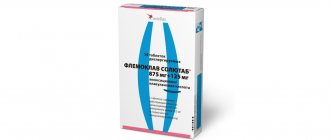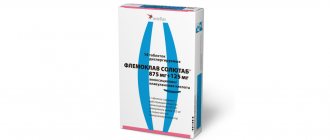Composition and release form
| Capsules | 1 caps. |
| cefixime | 200 mg |
| 400 mg | |
| excipients: colloidal silicon dioxide; magnesium stearate; carboxymethylcellulose; Azorubine | |
| capsule shell composition: titanium dioxide; dyes - D&C yellow 10, FD&C yellow 6, indigo carmine, FD&C blue; gelatin |
in a blister pack 6 pcs.; in a cardboard pack 1 package.
| Granules for preparation of suspension for oral administration | 5 ml |
| cefixime | 100 mg |
| excipients: sodium benzoate; sucrose; yellow resin; strawberry flavor |
in dark glass bottles of 60 ml; in a cardboard pack 1 bottle complete with a dosing spoon.
Description of the dosage form
200 mg capsules with a yellow cap and a white body, containing a mixture of powder and small granules of a yellowish-white color.
400 mg capsules with a purple cap and a white body, containing a mixture of powder and small granules of a yellowish-white color. The code H808 is marked on the capsule.
Granules for the preparation of suspension for oral administration: small granules from white to cream color. After dilution, the suspension is almost white to cream in color with a sweet strawberry aroma.
Pharmacodynamics
Inhibits the synthesis of the pathogen's cell membrane. Cefixime is resistant to beta-lactamases produced by most gram-positive and gram-negative bacteria.
In vitro, cefixime is active against gram-positive bacteria: Streptococcus agalactiae; gram-negative bacteria: Haemophilus parainfluenzae, Proteus vulgaris, Klebsiella pneumoniae, Klebsiella oxytoca, Pasteurella multocida, Providencia spp., Salmonella spp., Shigella spp., Citrobacter amalonaticus, Citrobacter diversus, Serratia marcescens.
In vitro and in clinical practice, cefixime is active against gram-positive bacteria: Streptococcus pneumoniae, Streptococcus pyogenes; gram-negative bacteria: Haemophilus influenzae, Moraxella (Branhamella) catarrhalis, E.coli, Proteus mirabilis, Neisseria gonorrhoeae.
Pseudomonas spp., Enterococcus (Streptococcus) serogroup D, Listeria monocytogenes, most Staphylococcus spp. are resistant to the drug. (including methicillin-resistant strains), Enterobacter spp., Bacteroides fragilis, Clostridium spp.
Suprax capsules 400 mg No. 6
Compound
Active substance: cefixime (in the form of trihydrate) - 400 mg. Excipients: colloidal silicon dioxide, magnesium stearate, calcium carmellose.
Pharmacokinetics
When taken orally, the bioavailability of cefixime is 40-50%, regardless of food intake, however, the Cmax of cefixime in serum is achieved faster by 0.8 hours when taking the drug with food. Binding to plasma proteins, mainly albumin, is 65%. About 50% of the dose is excreted unchanged in the urine within 24 hours, about 10% of the dose is excreted in bile. T1/2 depends on the dose and is 3-4 hours. In patients with impaired renal function with CC from 20 to 40 ml/min, T1/2 increases to 6.4 hours, with CC 5-10 ml/min - up to 11.5 hours.
Indications for use
Infectious and inflammatory diseases caused by sensitive microorganisms: pharyngitis, tonsillitis, sinusitis, acute and chronic bronchitis, otitis media, uncomplicated urinary tract infections, uncomplicated gonorrhea.
Contraindications
- hypersensitivity to cephalosporins and penicillins;
- children under 12 years of age;
- impaired renal function with CC less than 60 ml/min.
Directions for use and doses
For adults and children over 12 years of age weighing more than 50 kg, the daily dose is 400 mg (1 time/day or 200 mg 2 times/day). The duration of treatment is 7-10 days. For uncomplicated gonorrhea - 400 mg once.
Children under 12 years of age - 8 mg/kg body weight 1 time/day or 4 mg/kg every 12 hours.
For infections caused by Streptococcus pyogenes, the course of treatment should be at least 10 days.
In case of impaired renal function (with CC from 21 to 60 ml/min) or in patients on hemodialysis, the daily dose should be reduced by 25%.
With CC≤20 ml/min or in patients on peritoneal dialysis, the daily dose should be reduced by 2 times.
Storage conditions
Store out of the reach of children at a temperature of 15 °C to 25 °C.
Best before date
3 years. Do not use after the expiration date indicated on the package.
special instructions
Use with caution in elderly patients, patients with chronic renal failure or pseudomembranous colitis (history), and in children under 6 months of age.
With long-term use, normal intestinal microflora may be disrupted, which can lead to the growth of Clostridium difficile and cause the development of severe diarrhea and pseudomembranous colitis.
In patients with a history of allergic reactions to penicillins, manifestations of hypersensitivity to cephalosporin antibiotics are possible.
During treatment, a positive direct Coombs test and a false positive urine test for glucose are possible.
Description
III generation cephalosporin.
Dosage form
Capsules size No. 0, with a purple cap and a white body; with code “H808” printed in edible ink; the contents of the capsules are a yellowish-white mixture of powder and small granules.
Use in children
Contraindicated under the age of 12 years.
Pharmacodynamics
Semisynthetic cephalosporin antibiotic of the third generation for oral administration with a broad spectrum of action. Acts bactericidal. The mechanism of action is due to inhibition of the synthesis of the pathogen's cell membrane. Cefixime is resistant to the action of β-lactamases produced by most gram-positive and gram-negative bacteria.
In vitro, cefixime is active against gram-positive bacteria: Streptococcus agalactiae; gram-negative bacteria: Haemophilus parainfluenzae, Proteus vulgaris, Klebsiella pneumoniae, Klebsiella oxytoca, Pasteurella multocida, Providencia spp., Salmonella spp., Shigella spp., Citrobacter amalonaticus, Citrobacter diversus, Serratia marcescens.
In vitro and in clinical practice, cefixime is active against gram-positive bacteria: Streptococcus pneumoniae, Streptococcus pyogenes; gram-negative bacteria: Haemophilus influenzae, Moraxella (Branhamella) catarrhalis, Escherichia coli, Proteus mirabilis, Neisseria gonorrhoeae.
Pseudomonas spp., Enterococcus (Streptococcus) serogroup D, Listeria monocytogenes, most Staphylococcus spp. are resistant to cefixime. (including methicillin-resistant strains), Enterobacter spp., Bacteroides fragilis, Clostridium spp.
Side effects
From the digestive system: dry mouth, anorexia, diarrhea, nausea, vomiting, abdominal pain, flatulence, transient increase in the activity of liver transaminases and alkaline phosphatase, hyperbilirubinemia, jaundice, gastrointestinal candidiasis, dysbacteriosis; rarely - stomatitis, glossitis, pseudomembranous enterocolitis.
From the hematopoietic system: leukopenia, thrombocytopenia, neutropenia, hemolytic anemia.
From the side of the central nervous system: dizziness, headache.
From the urinary system: interstitial nephritis.
Allergic reactions: skin itching, urticaria, skin hyperemia, eosinophilia, fever.
Use during pregnancy and breastfeeding
Use during pregnancy is possible only when the expected benefit to the mother outweighs the potential risk to the fetus.
If necessary, use during lactation should stop breastfeeding.
Interaction
Blockers of tubular secretion, allopurinol, and diuretics delay the excretion of cefixime by the kidneys, which can lead to an increase in its concentration in the blood plasma.
With the simultaneous use of cefixime and carbamazepine, the concentration of carbamazepine in the blood plasma increases. Reduces the prothrombin index, enhances the effect of indirect anticoagulants. Antacids containing magnesium or aluminum hydroxide slow down the absorption of the drug, so the drug should be used 1-2 hours before or 4 hours after taking the above medications.
Overdose
Symptoms: increased adverse reactions, especially from the gastrointestinal tract, with the exception of allergic reactions.
Treatment: gastric lavage, symptomatic and supportive therapy, which, if necessary, includes the use of antihistamines, glucocorticosteroids, epinephrine, norepinephrine, dopamine, oxygen therapy, transfusion of infusion solutions, artificial ventilation. Cefixime is not removed in large quantities from the circulating blood by hemo- or peritoneal dialysis.
Impact on the ability to drive vehicles and operate machinery
Patients taking cefixime should be careful when driving vehicles and engaging in other potentially hazardous activities that require increased concentration and psychomotor reactions, taking into account the side effect profile.
Pharmacokinetics
When taken orally, the bioavailability of cefixime is 40–50%, regardless of food intake, however, the Cmax of cefixime in serum is achieved 0.8 hours faster when taking the drug with food.
When taking the drug in capsule form at a dose of 200 mg, Cmax in serum is achieved after 4 hours and is 2 mcg/ml, when taken at a dose of 400 mg - 3.5 mcg/ml. When taking the drug in the form of a suspension at a dose of 200 mg, Cmax in serum is achieved after 4 hours and is 2.8 mcg/ml, when taken at a dose of 400 mg - 4.4 mcg/ml. Binding to plasma proteins, mainly albumin, is 65%.
About 50% of the dose is excreted unchanged in the urine within 24 hours, about 10% of the dose is excreted in bile. T1/2 depends on the dose and is 3–4 hours.
In patients with impaired renal function, with a creatinine Cl of 20-40 ml/min, T1/2 increases to 6.4 hours, with a creatinine Cl of 5-10 ml/min - up to 11.5 hours.
Suprax Solutab, 400 mg, dispersible tablets, 7 pcs.
Due to the possibility of cross-allergic reactions with penicillins, it is recommended to carefully evaluate the patient's medical history. If an allergic reaction occurs, use of the drug should be stopped immediately.
If toxic epidermal necrolysis (Lyell's syndrome), Stevens-Johnson syndrome, drug rash syndrome with eosinophilia and systemic manifestations occur, cefixime should be discontinued and the necessary therapy should be carried out.
If anaphylactic shock develops, the drug must be stopped and epinephrine (adrenaline), systemic glucocorticosteroids and antihistamines administered.
Long-term use of the drug may disrupt the normal intestinal microflora, which can lead to excessive proliferation of Clostridium difficile
and the development of pseudomembranous colitis. If mild forms of antibiotic-associated diarrhea occur, it is usually sufficient to stop taking the drug. For more severe forms, corrective treatment is recommended (for example, vancomycin 250 mg orally 4 times a day). Antidiarrheal drugs that inhibit gastrointestinal motility are contraindicated in the development of pseudomembranous colitis.
Like other cephalosporins, cefixime can cause acute renal failure accompanied by tubulointerstitial nephritis. In case of acute renal failure, you should stop taking cefixime, take the necessary measures and/or prescribe appropriate treatment.
If Suprax® Solutab® is used simultaneously with aminoglycosides, polymyxin B, sodium colistimethate, and loop diuretics (furosemide, ethacrynic acid) in high doses, it is necessary to monitor renal function. After long-term treatment with Suprax® Solutab®, the state of hematopoietic function should be checked.
Dispersible tablets should only be dissolved in water. During treatment, a false-positive direct Coombs test and a false-positive urine test for glucose are possible when using some test systems for rapid diagnosis.
Impact on the ability to drive vehicles and operate machinery
No studies have been conducted on the effects of Suprax® Solutab® on the ability to drive vehicles and operate machinery. Due to possible adverse effects (eg dizziness), caution should be exercised.
Side effects
Allergic reactions: urticaria, skin hyperemia, itching, eosinophilia, fever.
From the digestive system: dry mouth, anorexia, nausea, vomiting, diarrhea, flatulence, abdominal pain, dysbiosis, liver dysfunction (increased activity of liver transaminases, alkaline phosphatase, hyperbilirubinemia, jaundice), gastrointestinal candidiasis; rarely - stomatitis, glossitis, pseudomembranous enterocolitis.
From the hematopoietic organs: leukopenia, neutropenia, thrombocytopenia, hemolytic anemia.
From the urinary system: interstitial nephritis.
From the nervous system: dizziness, headache.
Suprax (gran. for priming suspension. 100 mg/5 ml from 30.3 g to 35 g)
A country
Italy
The country of production may vary depending on the batch of goods. Please check with the operator for detailed information when confirming your order.
Active substance
Cefixime
Compound
The active substance is Cefixime.
pharmachologic effect
Antimicrobial, antibacterial (bactericidal). Inhibits the synthesis of peptidoglycan, the main structural component of the bacterial cell wall. Resistant to beta-lactamase. Active against many gram-positive and gram-negative microorganisms: Streptococcus pneumoniae, Streptococcus pyogenes, Streptococcus agalactiae, Haemophilus influenzae, Haemophilus parainfluenzae, Moraxella catarrhalis, E.coli, Proteus mirabilis, Proteus vulgaris, N. gonorrhoeae, Klebsiella pneumoniae, Klebsiella oxy toca, Pasteurella multocida , Providencia species, Salmonella spp., Shigella spp., Citrobacter diversus, Serratia marcescens, etc. Rapidly absorbed from the gastrointestinal tract. In the blood, more than half is bound to proteins (albumin). It is excreted in the urine mainly unchanged and in bile.
Indications for use
Urinary tract infections, otitis media, pharyngitis, tonsillitis, sinusitis, acute and chronic bronchitis, uncomplicated gonorrhea of the urethra and cervix.
Mode of application
As prescribed by a doctor.
Interaction
No information available.
Side effect
From the digestive system: dry mouth, anorexia, nausea, vomiting, diarrhea, constipation, abdominal pain, flatulence, transient increase in the activity of liver transaminases and alkaline phosphatase, hyperbilirubinemia, jaundice, gastrointestinal candidiasis, dysbacteriosis; rarely - stomatitis, glossitis, pseudomembranous enterocolitis. From the hematopoietic system: leukopenia, thrombocytopenia, neutropenia, hemolytic anemia, pancytopenia, aplastic anemia, bleeding. From the side of the central nervous system: dizziness, headache. From the urinary system: interstitial nephritis, impaired renal function, acute renal failure. Allergic reactions: skin itching, urticaria, skin hyperemia, eosinophilia, fever, erythema multiforme, toxic epidermal necrolysis, anaphylactic shock. Other: candidiasis, shortness of breath, development of hypovitaminosis B.
Contraindications
Hypersensitivity, pregnancy, breastfeeding (stop during treatment), children under 6 months of age.
Overdose
Symptoms: increased adverse reactions, especially from the gastrointestinal tract. Treatment: gastric lavage, prescription of antihistamines and glucocorticoids.
special instructions
Prescribe with caution to patients with gastrointestinal diseases, especially colitis. In case of impaired renal function or in patients on hemodialysis, the daily dose is reduced by 25%. When creatinine clearance is less than 20 ml/min, the dose is reduced by 2 times.
Dispensing conditions in pharmacies
On prescription
Directions for use and doses
Inside. For adults and children over 12 years of age weighing more than 50 kg, the average daily dose is 400 mg (once a day or 200 mg 2 times a day). The average duration of treatment is 7–10 days.
For uncomplicated gonorrhea - 400 mg once a day.
Children under 12 years of age are prescribed as a suspension at a dose of 8 mg/kg once or in 2 doses (4 mg/kg every 12 hours). For children aged 6 months to 1 year, the daily dose of the suspension is 2.5-4 ml, for children aged 2-4 years - 5 ml, for children aged 5-11 years - 6-10 ml. For diseases caused by Streptococcus pyogenes, the course of treatment is at least 10 days.
In case of impaired renal function, the dose is set depending on the serum creatinine clearance: with creatinine Cl 21–60 ml/min or in patients on hemodialysis, the daily dose should be reduced by 25%. When Cl creatinine is less than or equal to 20 ml/min or in patients on peritoneal dialysis, the daily dose should be reduced by 2 times.
Method for preparing the suspension: turn the bottle over and shake the powder. Add 40 ml of boiled water cooled to room temperature in 2 stages and shake after each addition until a homogeneous suspension is formed. After this, it is necessary to allow the suspension to stand for 5 minutes to ensure complete dissolution of the powder. The prepared suspension should be shaken before use.
Characteristic
Semisynthetic cephalosporin antibiotic of the third generation for oral administration.
Pharmacokinetics
When taken orally, the bioavailability of cefixime is 40–50%, regardless of food intake, however, the Cmax of cefixime in serum is achieved 0.8 hours faster when taking the drug with food.
When taking the drug in capsule form at a dose of 200 mg, Cmax in serum is achieved after 4 hours and is 2 mcg/ml, when taken at a dose of 400 mg - 3.5 mcg/ml. When taking the drug in the form of a suspension at a dose of 200 mg, Cmax in serum is achieved after 4 hours and is 2.8 mcg/ml, when taken at a dose of 400 mg - 4.4 mcg/ml. Binding to plasma proteins, mainly albumin, is 65%.
About 50% of the dose is excreted unchanged in the urine within 24 hours, about 10% of the dose is excreted in bile. T1/2 depends on the dose and is 3–4 hours.
In patients with impaired renal function, with a creatinine Cl of 20-40 ml/min, T1/2 increases to 6.4 hours, with a creatinine Cl of 5-10 ml/min - up to 11.5 hours.
Pharmacodynamics
Inhibits the synthesis of the pathogen's cell membrane. Cefixime is resistant to beta-lactamases produced by most gram-positive and gram-negative bacteria.
In vitro, cefixime is active against gram-positive bacteria: Streptococcus agalactiae; gram-negative bacteria: Haemophilus parainfluenzae, Proteus vulgaris, Klebsiella pneumoniae, Klebsiella oxytoca, Pasteurella multocida, Providencia spp., Salmonella spp., Shigella spp., Citrobacter amalonaticus, Citrobacter diversus, Serratia marcescens.
In vitro and in clinical practice, cefixime is active against gram-positive bacteria: Streptococcus pneumoniae, Streptococcus pyogenes; gram-negative bacteria: Haemophilus influenzae, Moraxella (Branhamella) catarrhalis, E.coli, Proteus mirabilis, Neisseria gonorrhoeae.
Pseudomonas spp., Enterococcus (Streptococcus) serogroup D, Listeria monocytogenes, most Staphylococcus spp. are resistant to the drug. (including methicillin-resistant strains), Enterobacter spp., Bacteroides fragilis, Clostridium spp.



